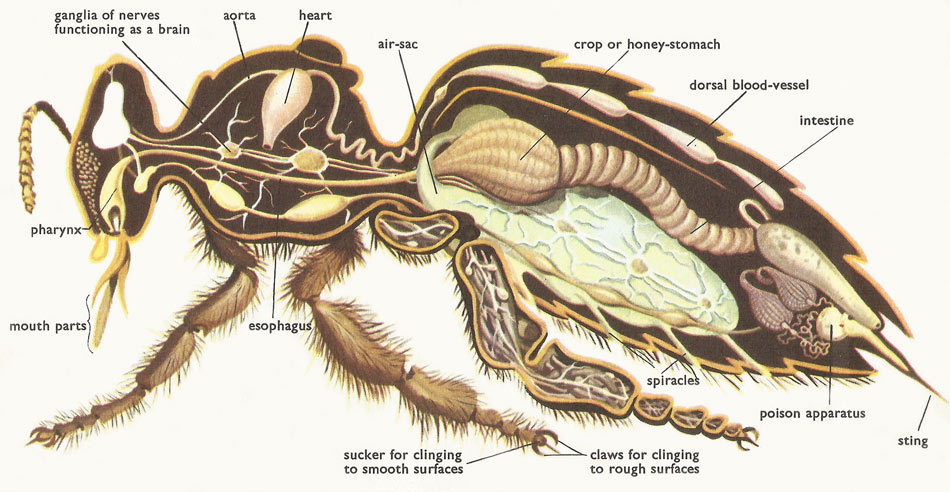
Have you ever wondered what lies beyond the buzz of a bee? In this article, we will take a fascinating journey into the intricate world of bee anatomy. From their intricate compound eyes to their specialized mouthparts, we will explore the remarkable features that make bees such incredible pollinators. Get ready to discover the hidden wonders of these small creatures and gain a greater appreciation for the important role they play in our ecosystem. Let’s dive into the mesmerizing world of bee anatomy!
External Anatomy
Bees have a fascinating and unique anatomy, with distinct features that make them such efficient and essential creatures in our ecosystems. Let’s explore the external anatomy of bees, starting with their head.
Head
The head of a bee is a marvel of nature. It houses several important structures that contribute to the bee’s survival and functionality. One of the most striking features of a bee’s head is its compound eyes. These large, prominent eyes consist of thousands of individual lenses called ommatidia, allowing bees to see a panoramic view of their surroundings. The compound eyes provide excellent vision, helping bees navigate through complex environments with precision.
In addition to compound eyes, bees also have simple eyes, known as ocelli, located on the top of their head. These simple eyes are responsible for detecting the presence of light and dark, aiding in orientation and flight patterns.
Another prominent feature on a bee’s head is its antennae. These slender sensory organs play a crucial role in communication and perception. Bees use their antennae to detect pheromones released by other bees, enabling them to communicate important information about food sources, danger, and even queen status. Antennae also help bees navigate their environment by sensing vibrations in the air, providing crucial information about wind direction and speed.
Lastly, the mouthparts of a bee are essential for their survival. Bees have a sophisticated proboscis, a tubular structure that functions as both a straw and a tongue. This adaptable mouthpart allows bees to suck nectar from flowers, collect pollen, and even feed on other liquid food sources. The mouthparts of a bee are perfectly adapted to their specialized diet and play a vital role in pollination, as they inadvertently carry pollen from flower to flower while feeding.
Thorax
Moving down to the central part of a bee’s body, we find the thorax. The thorax is the powerhouse of the bee, housing essential organs and structures that enable flight and movement.
A bee’s thorax is equipped with three pairs of legs, each consisting of specialized structures. The legs are utilized for a multitude of functions, including feeding, grooming, walking, and carrying pollen. These intricate appendages are covered in microscopic hairs that assist in pollen collection and aid in navigation, as they can sense textures and vibrations.
Above the legs, bees possess two pairs of wings that are crucial for their ability to fly. The wings of bees are transparent and veined, allowing them to withstand the vigorous flapping required for flight. The coordinated movement of the wings generates the distinctive buzzing sound that bees are known for. The thorax’s muscles, attached to the wings, contract and relax rapidly, propelling the bee through the air with remarkable agility.
Abdomen
The abdomen, located at the rear end of a bee, is where some of the most intriguing structures reside. Notable features of the bee’s abdomen include the stinger and wax glands.
The stinger, found exclusively in female bees, serves as a defense mechanism. It is a modified ovipositor that, when deployed, injects venom into potential threats. The venom acts as a deterrent and may cause painful reactions in animals that come into contact with it. It’s important to note that only some species of bees have stingers, while others, like bumblebees, do not.
Wax glands, on the other hand, are responsible for the production of beeswax. Specialized glands located on the underside of the abdomen secrete liquid wax, which bees use to construct their honeycombs. The wax is initially soft and malleable but hardens over time, providing structural stability to the hive. Beeswax also serves as a storage medium for honey and pollen, making it an essential component of their life cycle.

Internal Anatomy
While the external anatomy of bees showcases their unique physical traits, the internal anatomy is equally fascinating. The internal systems of bees play critical roles in their physiological functions, ensuring their overall survival and success as a species. Let’s delve into the intricate internal anatomy of bees.
Digestive System
Bees have a highly specialized digestive system that is perfectly adapted to their dietary needs. This system consists of several interconnected organs that work together to process and extract nutrients from their food sources.
Starting with the mouthparts, bees have a proboscis, a tubular structure that functions as a straw and a tongue. The proboscis allows bees to suck nectar from flowers and collect liquid food sources. As the nectar enters the bee’s mouth, it encounters the salivary glands, which secrete enzymes that break down complex sugars into simpler forms for easy absorption.
Once inside the bee, the nectar travels to the crop, a temporary storage organ in the upper part of the digestive tract. The crop acts as a reservoir, holding the incoming nectar until it can be transferred to other bees or processed further. From the crop, the nectar is then regurgitated and placed into cells within the hive, where it becomes honey.
Beyond the crop, the nectar progresses into the honey stomach, the bee’s main storage compartment for nectar. Here, enzymes, brought in from other bees, are added to the nectar to facilitate the process of converting it into honey. The honey stomach is highly expandable, allowing it to store a significant amount of nectar for later use.
As the nectar continues its journey through the digestive system, it enters the midgut, where further enzymatic breakdown occurs, breaking down complex sugars into more manageable forms. Here, the majority of nutrient absorption occurs, ensuring that the bee obtains the necessary energy and resources from its food.
The digested material then moves into the hindgut, where the final absorption of water and nutrients occurs. Any remaining undigested material progresses into the rectum, where waste products are eliminated from the body.
Respiratory System
Bees rely on a unique respiratory system to meet their oxygen requirements. Unlike mammals, which have lungs, bees have a network of tracheal tubes that transport oxygen throughout their body.
The tracheal tubes begin with small openings called spiracles, located on the exterior of the thorax and abdomen. These tiny openings allow air to enter the body and reach the tracheal system. Once inside, the tracheal tubes branch out, delivering oxygen directly to the bee’s cells, ensuring efficient gas exchange.
In addition to providing oxygen, the respiratory system also helps bees regulate their body temperature. By adjusting the rate and depth of their breathing, bees can control the amount of heat they retain or release, maintaining optimal body temperature.
Circulatory System
The circulatory system of bees, known as the hemolymph, plays a vital role in transporting nutrients, hormones, and immune cells throughout the body. Unlike mammals, bees have an open circulatory system, meaning that the hemolymph flows freely within their body cavity.
At the center of the circulatory system is the heart, a simple tube-like structure located along the dorsal side of the bee’s body. The heart contracts rhythmically, pumping the hemolymph forward and distributing it to various organs and tissues.
Hemolymph serves multiple functions within bees’ bodies. It not only transports essential substances but also plays a role in the immune response, acting as a defense against pathogens and infections.
Nervous System
The nervous system of bees is highly developed and plays a crucial role in their behavior, communication, and survival. At the heart of this system is the brain, located within the head. The bee’s brain processes sensory information, integrates it, and generates appropriate responses.
In addition to the brain, bees have ganglia, which are clusters of nerve cell bodies distributed throughout their body. These ganglia act as relay stations, processing sensory information and coordinating specific functions. The complex network of nerves connects the ganglia and brain, allowing for rapid transmission of signals.
The nervous system is crucial for bees’ ability to navigate, communicate, and carry out intricate tasks within the hive. Through intricate dances and chemical signals, bees convey important information to their hive mates, enabling effective communication.
Reproductive System
The reproductive system of bees is responsible for the continuation and propagation of their species. Within a hive, there are several distinct roles and functions performed by different types of bees.
The queen bee, as the name suggests, is the sole reproductive female in the hive. She possesses specialized reproductive organs, including ovaries, which produce eggs. The queen bee’s main function is to lay eggs, ensuring the colony’s growth and survival. Mating occurs only once in her lifetime, allowing her to store sperm from multiple partners to fertilize eggs as needed.
Worker bees, the non-reproductive females, play a vital role in the hive’s functioning. Their reproductive system is underdeveloped, with ovaries that do not mature for egg production. Instead, worker bees carry out tasks such as foraging, nursing the brood, and maintaining the hive’s infrastructure.
Lastly, drones are male bees whose sole purpose is to mate with the queen bee. Their reproductive system is well-developed, with testes producing sperm. Drones spend much of their time hovering around the hive, waiting for the opportunity to mate. Once they have fulfilled their reproductive duty, drones typically die or are expelled from the hive.
In conclusion, the intricate and fascinating anatomy of bees is a testament to their remarkable adaptability and crucial role in our ecosystem. From their compound eyes and proboscis to their tracheal tubes and wax glands, every aspect of a bee’s anatomy plays a vital role in its survival and success. Understanding the finer details of bee anatomy allows us to appreciate the complexity and beauty of these incredible creatures. So the next time you encounter a bee, take a moment to marvel at the wonders of their external and internal anatomy.
